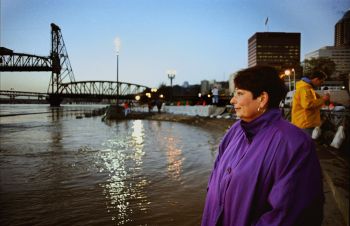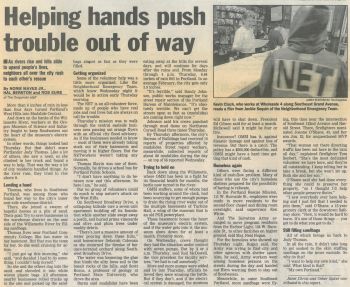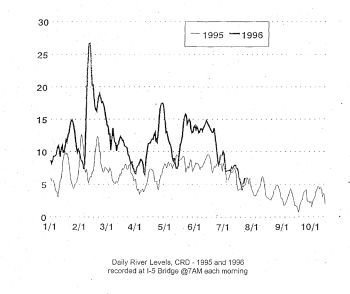1996 High Water Flood: Difference between revisions
| Line 30: | Line 30: | ||
|} | |} | ||
[[File:1996 Flood Graph.jpg|alt=River level graph on page 11 of the original AAR document. The graph doesn't clarify the Columbia or Willamette river, only saying that readings are taken at the I-5 bridge.|thumb|''River level graph on page 11 of the original AAR document. The graph doesn't clarify the Columbia or Willamette river, only saying that readings are taken at the I-5 bridge.''|350x350px]] | [[File:1996 Flood Graph.jpg|alt=River level graph on page 11 of the original AAR document. The graph doesn't clarify the Columbia or Willamette river, only saying that readings are taken at the I-5 bridge.|thumb|''River level graph on page 11 of the original AAR document. The graph doesn't clarify the Columbia or Willamette river, only saying that readings are taken at the I-5 bridge.''|350x350px]] | ||
[[File:Katz 96 Flood.jpg|alt=Mayor Katz watching the 96 flood.|thumb|350x350px|''Portland Mayor Vera Katz stands along "[https://www.wweek.com/portland/article-23431-feb-8-1996-vera-katz-builds-her-wall.html Vera's Wall]", where volunteers filled and dropped approximately 40,000 sandbags to keep waters from topping over Waterfront Park.'']] | |||
The aftermath of the 1996 flood led to discussions and efforts to improve flood management and infrastructure resilience in the affected areas. It remains an important event in Oregon's history, highlighting the impact of severe weather on communities and the need for preparedness and response measures. | The aftermath of the 1996 flood led to discussions and efforts to improve flood management and infrastructure resilience in the affected areas. It remains an important event in Oregon's history, highlighting the impact of severe weather on communities and the need for preparedness and response measures. | ||
| Line 90: | Line 91: | ||
|The EMC will be asked to address this issue at their own bureau level. | |The EMC will be asked to address this issue at their own bureau level. | ||
|} | |} | ||
=== Other AAR callouts concerning volunteers === | === Other AAR callouts concerning volunteers === | ||
Revision as of 16:50, 23 December 2023
On February 18th 1996, Oregonian reporter Brian T. Meehan summarized the disaster this way:
"In Downtown Portland, the Willamette crested at 28.6 feet, the top of the harbor wall. Downstream, the Columbia hissed at double the normal current - half again bigger than the Mississippi. Thousands lined the waterfront for a peek at the Willamette, awash in logs and heartache. The river's power was humbling. A line from T.S. Eliot echoed: 'I do not know much about gods; but I think that the river is a strong brown god - sullen, untamed and intractable.' Floodwaters tore through Tualatin, Oregon City and Lake Oswego. Rising waters and tumbling hillsides isolated Tillamook and devastated the Columbia County towns of Vernonia, Clatskanie and Mist. Mud and ruin spilled, but a curious value surfaced. The flood bound people in ways urban life rarely does. Volunteers erected a plywood barrier along Portland's harbor wall. Strangers hauled furniture for people they'll never meet again. Convicts loaded sandbags. Young people led the way. Students from Milwaukie and Rex Putnam high schools reached out to Oak Grove. West Linn students sandbagged a flooded restaurant in arch rival Oregon City. Oregon City, Lake Oswego and Tigard students traded schoolbooks for shovels. Across Oregon, selfless acts knit a new definition of community. Under the worst conditions, many Oregonians put strangers first in the miracle that is the human spirit."
The February Flood of 1996 response is of interest to both NET volunteers and to the history of emergency management in Portland. For NET volunteers, the 1996 Flood brought the first documented NET deployment event. For Portland, it was the first major disaster response in the "modern era" of emergency management.[1]
NET Roles in the 1996 Flood
The 1996 Flood is the first documented deployment of NET volunteers. The Portland AAR mentions two volunteers (presumably NETs) assisting five other personnel in the EOC. Alongside spontaneous volunteers, NETs also undoubtedly helped to sandbag and erect barrier fences. However, no record recovered by PBEM says exactly how many NETs deployed.
Most notably, PF&R deployed NET volunteers to distribute information to business owners in the central eastside. The Oregonian mentioned NETs engaging in this activity in an article posted to the right on this page.
1996 Portland Floods: Background
The Flood of 1996 in Oregon was a severe weather event that took place in February of that year. It was characterized by heavy rainfall, high winds, and flooding, affecting several regions in the Pacific Northwest, including Portland. The Willamette River crested at 28.55 feet, where the typical level in February is seven feet. According to Joseph Rose with The Oregonian, a convergence of weather events contributed to the flood's cause:
- Abnormally high rainfall (7.12 inches, 125% above normal) that saturated the soil and had rivers running high in January.
- Heavy snowfall in the mountains in late January.
- A weeklong deep freeze in the valley. A headline in the Feb. 2, 1996, Oregonian read: "Cold weather makes plumbers hot item."
- On Feb. 6, 1996, a warm Pineapple Express jetstream melted the snow while bringing a heavy deluge of rain. That was the trigger.
- Within hours, every body of water in the region and many on the Oregon Coast suddenly went to flood stage and beyond.[2]
Tragically, the Flood of '96 resulted in eight fatalities, with at least four people losing their lives in one day alone. The flood led to over one hundred landslides in Portland alone and caused millions of dollars in highway damage. Total damages across the region exceeded $1 billion.[3]
The 1996 After Action Report
| To download a copy of the 1996 After Action Report, CLICK HERE. |

The aftermath of the 1996 flood led to discussions and efforts to improve flood management and infrastructure resilience in the affected areas. It remains an important event in Oregon's history, highlighting the impact of severe weather on communities and the need for preparedness and response measures.
The Portland AAR from the flood is itself a telling piece of work in the respect that the AAR recommendations/improvement plan is nearly identical to recommendations often seen in City of Portland AARs in decades since. The table below summarizes the report findings. Boxes highlighted in yellow indicate a plan item that ultimately contributed to the development of Portland NET.
| # | Basic Plan Issue | Identified Need | Planned Action |
|---|---|---|---|
| #1 | "The situations addressed by this Plan are those in which the actions of many different bureaus must be coordinated." | Continue to identify Bureaus needing to be more involved or involved at different levels. Reassignment of employees, volunteer management and section job descriptions have been identified as areas needing attention. | As of January1997 the Basic Plan revision includes reference to job descriptions, including time commitments, and bureau tasks. This will facilitate greater City-wide coordination for the emergency management process. A plan for recruitment and training will be developed for incoming and retained EOC responders. |
| #2 | "It is important to realize that no one bureau is going to rescue a City during a disaster situation. Further, it is true that City government agencies will not possess all resources and talent necessary to protect the citizens of the City." | For those who participate as EOC responders, a greater understanding of Bureau resources, responsibilities and capabilities has developed as a result of the relationships built during training, exercises, and actual occurrences. This coordination and familiarization is a subsequent benefit from the process of preparing to respond as a City unified force. The need here is to continue to refine each bureaus and employees' capabilities and responsibilities during a disaster. | The understanding of each Bureau's responsibility as a primary or secondary responder, their identification of personnel and definition of their duties during emergency activation needs to be decided upon and made a part of their Basic Plans. As developed, these Bureau specific decisions, will be incorporated into the plan. |
| #3 | "For this reason, the City has endorsed a three tier EMC[4] concept. This concept blends the legal mandates of the government structure with the private resources of the community. By working together and maintaining open lines of communication, we will be able to field and coordinate a tremendous amount of resources and talent." | The responsibility of the EMC as outlined in the Basic Plan on page 9 is to "plan exercise schedule, budget recommendations, public education, update bureau and office plans, coordinate training, make recommendations to the Disaster Policy Council (DPC), meet as necessary and involve bureaus and office directors." The Mayor and Council has approved the plan with these responsibilities listed and yet it is uncertain whether all EMC members recognize their part in City Emergencies. These responsibilities need to be clarified and reaffirmed by the EMC. | As of January, 1997 the job description of the EMC will be changed to" Approve exercise schedule; coordinate public education; make budget recommendations; coordinate Bureau and Office plans with the Basic Plan; approve training coordination; Make recommendations to the Disaster Policy Council" in the Basic Plan. |
| #4 | "The Chief of the Portland Bureau of Fire, Rescue and Emergency Services, the Emergency Manager and the Portland Office of Emergency Management (POEM)[5] are charged with the responsibility to develop and implement an all hazards emergency management plan in the City of Portland." | POEM needs to continue giving assistance in Basic Plan compliance through training, exercises, and technical expertise. POEM will continue to integrate the results of exercises and actual events into the development of the all hazards plan. | The EMC, through its growth and development, will further identify and define the responsibilities of the bureaus and continue to facilitate a cooperative working environment. Future exercises will incorporate appropriate sections of the Basic Plan. |
| #5 | "This Plan attempts to define in a straight forward manner who does what, when, where, and how in order to mitigate, prepare for, respond to, and recover from the effects of disasters." | The plan needs to better define Bureau involvement. | The EMC will review and approve the update of Plan (as prepared by POEM Staff) to define and determine bureau and employee involvement. This updated plan should be submitted to the DPC for approval. |
| #6 | "A disaster occurrence will require prompt and effective emergency response and recovery operations by the City government.'' | Need better continuity between response and recovery phases. | Training, identified in review of the flood, will be developed to provide responders with a greater understanding of the relationship between the phases and transitional process. |
| #7 | "Secondary city emergency operations will be based on the principle of self-help." | Need greater understanding of complimentary aspects of Neighborhood Emergency Teams to the functions of Emergency Responders; More employee training on emergency preparedness, mitigation, response, and recovery in the workplace and at home; Task specific training for sections such as crisis communication; More public education on disaster planning for organizations, businesses and industry. | NET training continues to instruct citizens in 72 hour self sufficiency in the time of an emergency. Greater employee training is in the planning stage. Business and industry training is available through the Fire Bureau, Red Cross and other agencies. Inside Line will release regionally coordinated messages in January. The Flood Mitigation Workgroup recommended the development of an outreach and public information program to inform people of flood and landslide risks, mitigation measures and flood insurance. |
| #8 | "City government will bear the responsibility for utilizing all available local resources." | Identification of local resources is a part of the planning and exercise process. POEM needs to develop city legislation necessary to avoid gouging by vendors and contractors during emergencies. This legislation should not only protect city agencies but the general public. The Logistics Section needs to continue to compile a list of contracted vendors. | The EMC will be asked to review the proposed legislation. The Logistics section Chiefs will be encouraged to compile a list. |
| #9 | "Day to Day functions that do not contribute directly to the emergency may be suspended for the duration of any emergency. The efforts that would normally be required for those functions will be redirected to the accomplishment of emergency task by the bureaus or agencies concerned." | Disaster responders need to be excused from their normal responsibilities until they are no longer needed at the EOC or in the field/task. They also need to be available on an as needed basis during the recovery phase. Bureaus need to identify non-critical City functions that can be suspended during a disaster and those who can be reassigned to accomplish critical functions. | The Bureau plans will reflect the aforementioned concept of critical/non-critical operations of their work and workforce. |
| #10 | "Portland will structure its response to and management of a disaster by using the Incident Command System..." | Bureau Managers and key personnel need to develop and exercise disaster plans in accordance with the Incident Command System. Identify Bureau emergency operations personnel, develop Bureau specific emergency plans and provide training and exercises for their personnel. | The EMC will be asked to address this issue at their own bureau level. |
Other AAR callouts concerning volunteers
- Page 17 in the Logistics section (Staffing subsection) describes the critical need for a Volunteer Coordinator.
- Page 42 mentions the need for PF&R to develop an emergency volunteer program.
References and Notes
- ↑ "Modern era of emergency management" would include any major disaster since 1979, when President Jimmy Carter signed an executive order to create the Federal Emergency Management Agency. Prior to that year, disaster response at the federal level was fragmented across agencies. Portland had, of course, experienced disasters prior to the 1996 flood. But it appears the flood was the incident that involved local bureaus collaborating using the Incident Command System (ICS).
- ↑ Oregonian/OregonLive, J. R. |. (2020, February 5). Remembering Oregon’s epic 1996 flood (photos). Oregonlive. https://www.oregonlive.com/history/2016/02/oregon_flood_of_1996_20_years.html
- ↑ NOAA’s National Weather Service. (n.d.). Flooding in Oregon. https://www.weather.gov/safety/flood-states-or
- ↑ EMC stands for "Emergency Management Committee", which later became the EMSC (Emergency Management Steering Committee) that exists today.
- ↑ POEM later became PBEM.

